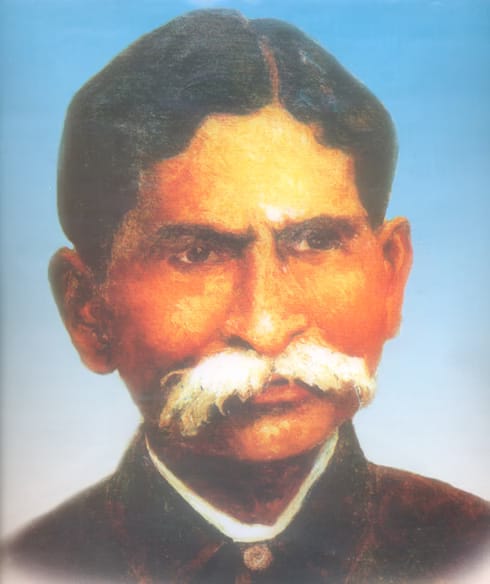Table of Contents
Introduction
Radhanath Ray (1848–1908) is fondly remembered as the Father of Modern Odia Poetry and the Father of the New Era of Oriya Literature. At a time when Odia was under threat of being absorbed into Bengali, Ray’s pen safeguarded the language, modernized its poetry, and gave it a new identity. His works like Kedar Gouri, Chilika, and Darbar exemplify a break from medieval ornate styles, instead embracing romanticism, realism, nationalism, and humanism.
Early Life and Education
- Born on 28 September 1848 in Kedarpur, Balasore.
- Lost his mother at eight, leaving him melancholy and introspective, traits visible in his poetry.
- Brilliant student, first from Balasore to pass matriculation from Calcutta University.
- Initially admitted to Presidency College, Calcutta, but poverty and ill-health forced him to leave.
- Began as a teacher at Balasore High English School (1864), later rising to Divisional Inspector of Schools.
Defender of Odia Language and Culture
In the late 19th century, Odia faced extinction due to the dominance of Bengali in administration and education.
- Bengali educationists argued Odia was a dialect of Bengali.
- John Beames, a British officer, countered this, proving Odia was older and richer than Bengali.
- Radhanath, with Fakir Mohan Senapati and Madhusudan Rao, fought against this suppression.
- Promoted Odia textbooks and supported the Utkal Darpan, Odisha’s first literary journal.
This effort tied his literary role to cultural nationalism—preserving Odisha’s identity through literature.

Literary Career
Early Writings
- Began in Bengali with Kabitabali (1873).
- Shifted to Odia, pioneering modern poetry.
Major Works (1880–1898)
- Kedar Gouri (1886) – Tragic romance inspired by Ovid’s Pyramus and Thisbe, yet adapted to Odisha’s geography, culture, and folklore.
- Chandrabhaga (1886) – Rich depictions of Puri and the Chandrabhaga river.
- Nandikeswari (1887) – Fusion of Western myth and Odia landscape.
- Usha (1888) – Romantic mythological narrative.
- Parvati (1891) – Partly inspired by the Greek tragedy Agamemnon.
- Chilika (1892) – Tribute to Chilika Lake, embedding nature into national identity.
- Mahayatra (1893) – Philosophical exploration, using blank verse for the first time in Odia poetry.
- Darbar (1896) – A satirical reflection on colonial governance.
- Jajati Keshari (1898) – Based on Odisha’s historical king.
- Meghaduta – Translated from Kalidasa.
Literary Innovations
Rejection of Riti Yuga
- Predecessors like Upendra Bhanja wrote ornate, erotic, courtly poetry (Riti Yuga).
- Ray rejected excessive ornamentation, preferring clarity, colloquial diction, and realism.
- His poetry balanced Western Romantic influence (Wordsworth, Ovid) with Odia sensibility.
Themes and Style
- Romanticism & Nature – Odisha’s rivers, valleys, forests, and Chilika Lake became poetic subjects.
- Humanism – Characters reflected psychological depth, not just mythological grandeur.
- Female Identity – Unlike earlier poets, Ray portrayed women as real, emotional beings—not eroticized objects.
- Philosophy of Love – Went beyond physical passion, exploring psychological torment, death-consciousness, and metaphysical unionIJCRT24A4393.
Kedar Gouri – A Literary Milestone
Kedar Gouri (1886) is often considered his masterpiece:
- A tragic romance modeled on Ovid’s Pyramus and Thisbe.
- Ray localized the foreign legend, setting it in Odisha’s Balasore and Cuttack landscapes, weaving local temples and flora into the narrative.
- The tale of Kedar and Gouri—two forbidden lovers who eloped and tragically committed suicide—symbolizes love transcending social taboos.
- Unlike the sensuality of earlier Riti poets, Ray elevated love to spiritual dimensions, merging realism with destiny and metaphysics.
- Critics call it an act of “transcreation”—not mere imitation, but adaptation that made a Roman story feel authentically OdiaIJCRT24A4393.
The Bhanja–Radhanath Debate
- In late 19th-century Odisha, literary circles split:
- Bhanja supporters valued ornate, sensuous poetry.
- Ray supporters hailed his modern simplicity and realism.
- This Bhanja–Radhanath controversy played out in journals like Indradhanu and Bijuli.
- Ray eventually diffused the conflict with humility in his poem Chilika, acknowledging Baladev Bhanja as a master while still carving his own pathIJCRT24A4393.
Prose and Essays
- First modern Odia essayist and travelogue writer.
- Essays on social reform, education, and nationalism furthered Odia intellectual life.
Legacy and Influence
- Called “The Age of Radhanath” in Odia literature.
- Elevated nature and Odia identity in poetry, akin to what Kalidasa did for India.
- Inspired future poets like Madhusudan Rao, Gangadhar Meher, and the Satyabadi poets.
- His works remain central to Odia cultural identity, taught in schools and celebrated in Odisha’s collective memory.
Death and Remembrance
Radhanath Ray passed away on 17 April 1908, but his works continue to shape Odisha’s literary and cultural heritage. His legacy rests not only in his poems but in his role as a guardian of Odia language and culture.
Conclusion
Radhanath Ray was more than a poet—he was a literary reformer, cultural nationalist, and modernizer. His works fused Western influence with Odia soil, rejected excessive ornamentation, dignified women in literature, and infused local landscapes into national consciousness. Kedar Gouri, Chilika, and Darbar remain timeless testaments to his genius.
Modern Odia literature is rightly known as the Age of Radhanath.